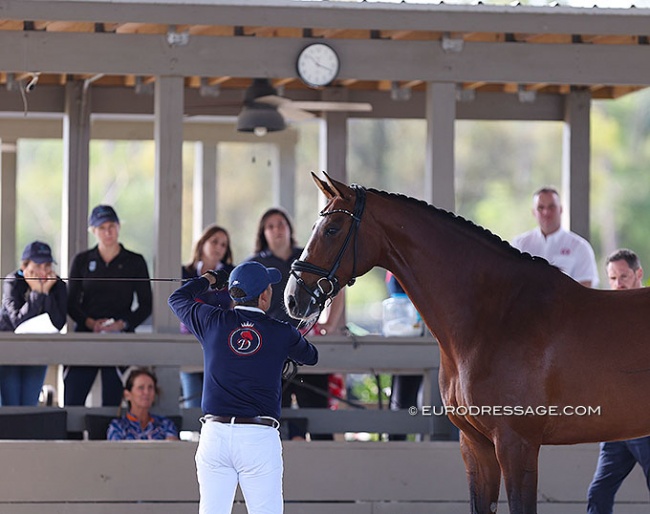
Breeding horses is not for the faint hearted and while stallion owners put their best foot forward in marketing their sires on traditional and social media platforms, breed societies are fairly silent in stressing the importance of a good mare for future breeding success.
Mares have fewer platforms to shine on except at annual elite mare shows, after which most of them disappear into a breeding barn as a producer. Compared to thriving business of dressage horse breeding in Europe, breeders in North America feel lost as they struggle with semen supply and quality, inflated veterinary rates, and lack of a market to sell their foals.
These issues prompted Poinciana's owner and manager, Jane Cleveland, to approach Oldenburg's North American representative Jens Richter at the 2023 Oldenburg Stallion Licensing in Vechta (GER) in January. She invited him to speak at her farm to interested breeders and Jens took charge and got Oldenburg breeding director Bernhard Thoben involved.
What initially was planned as a simple talk for curious minds developed into the first annual German Oldenburg Verband (GOV) North American Breeders' Meeting at Poinciana Farm in Loxahatchee Groves, Florida, on 18 February 2023. Sharon Downes assisted in the planning and co-ordination while Richter brought ClipMyHorse.tv onboard. The entire day was filmed and streamed live. It can be rewatched here.
Craving to Learn

Those who picked up on the invitation on Facebook were rewarded to a full day of inspirational lessons, presentations and group session in which breeders brainstormed about the possibilities to improve the market platforms for U.S. born foals.
The day began with coffee and donuts. While most initially declined a taste of the colourful, sugar bomb donuts, it only took fifteen minutes for them to change their mind and put their teeth in one. The German Oldenburg Verband had sent over Bernhard Thoben and Jens Richter, the North American GOV manager and an inspection judge.
First introductions were made in the Poinciana lounge, before everyone headed to the covered arena for the learning to begin.
Mock Mare Presentation
The morning session comprised a "mock mare presentation" in which Thoben assessed six mares, aged 2 to 15, professionally presented in hand by one of America's best handlers, King Santacruz. The mares were groomed to perfection and were either dressage or hunter bred.
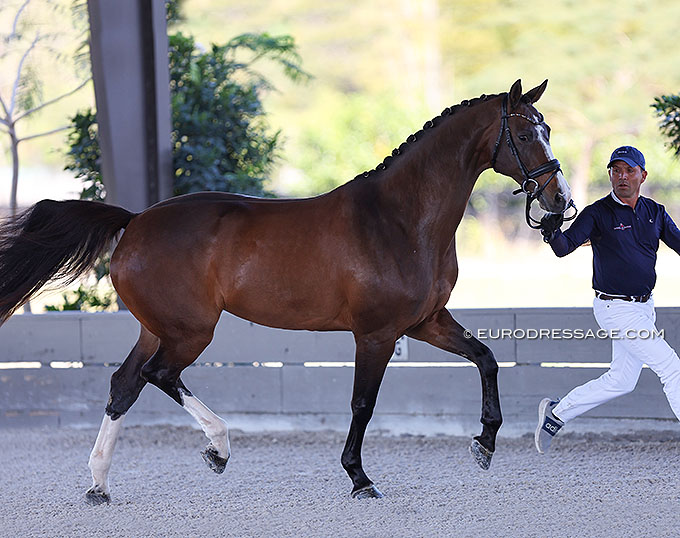
A breeding programme begins and ends with the mare and the better the quality of the mare, the more likely success will be achieved. Thoben began by stressing the significance of the mare performance test. It includes a presentation on hard surface to assess the correctness of the hoof and the way of walking; a ridden presentation under the own rider as well as a test rider; followed by presentation in hand for the assessment of the conformation.
The GOV uses "linear scoring," an elaborate two-page score sheet to rate the conformation and movement in hand of a horse. The score scale goes from -3, -2, -1, 0, 1, 2, 3.
"We start assessing at zero and go and down the linear scale," he said. "We look at the mouth and see if it's too short and difficult to fit a bit, for instance. All people have a good and bad side and this is also with horses. We always look at the horse at both sides."
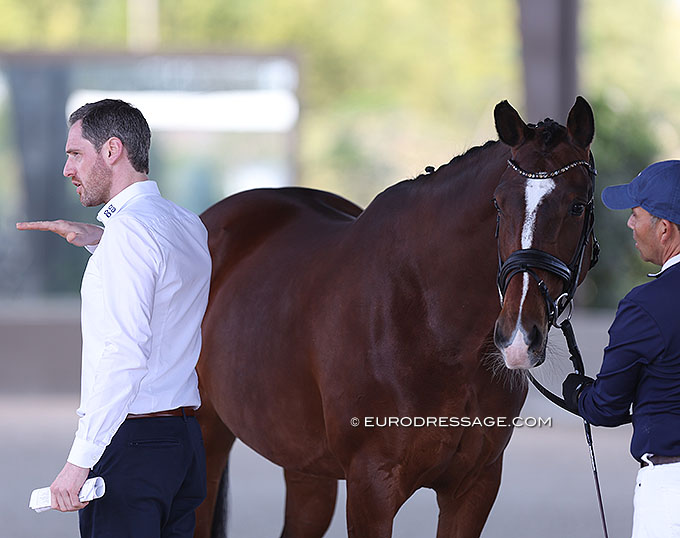
by Sezuan x Sandro Hit
Thoben addressed the audience and often asked them what score they would gave the mare in front of them. An open discussion about the stronger and weaker points in the conformation of the horse in front followed, which led to interesting insights. "No horse is perfect," Thoben added.
When of the horses presented was a bit tense and did not show the best walk at first. "What is the best walk," Thoben asked. "Lots of overtrack? For us it's a safe rhythm and an active one.With a lazy walk you have no clarity. To get the V-line in the rhythm the mare needs to have the activity behind. Give the horse the time to present a good walk and for it to relax."

performance test
A member in the audience asked the rhetorical question why studbooks then approve tall breeding stallions standing over 1.75m who impress with their imposing gaits. Doesn't this conflict with the concern about size?
In the end, Thoben highlighted that the breeding goal is "rideability" and this gets judged in the ridden test under the rider and test rider. "It weighs heavily," he said. "The marketing of the stallions is really big, but it starts with the mares."
GOV - How the Registry Works
After experiencing a mock mare presentation and one mare performance test presentation, the group moved back into the lounge where Bernhard Thoben gave a powerpoint presentation of the German Oldenburg Verband and how the registry works.
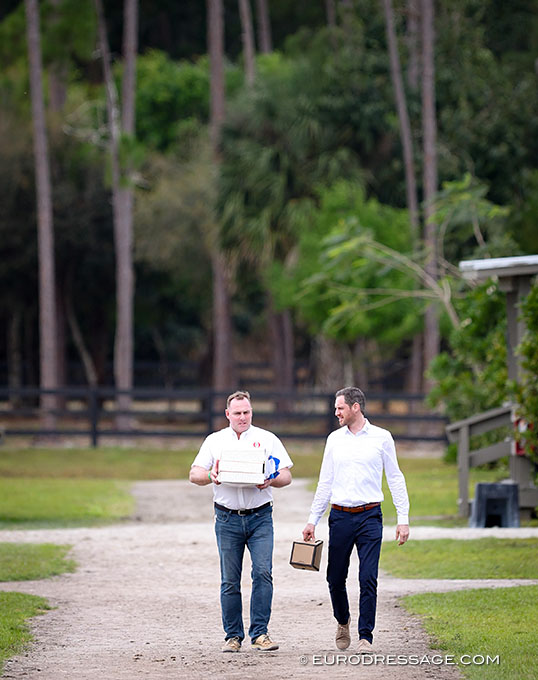
The most famous mare lines in Oldenburg are the Loretta line (dam of Sandro Hit) and Weihegold, who produced no less than 13 ET foals: 8 fillies of which 3 are elite and 5 colts of which 2 are licensed.
"Oldenburg had around 7500 foals registered in 2022, which was the most in Germany," Bernhard said with a smile. Foals in Germany can obtain a premium or elite title at foal inspections or can get the title of "foal of distinction" if the mare is not studbook I. A current trend, however, is that "breeders no longer like taking their foals to inspections," Bernhard added.
Mares can become "Verband Premium," or "Special Premium" mare when she has one foal. For "Elite" status breeders need to apply for that label themselves, but "she herself or her offspring needs to earn enough points." Oldenburg has 12,000 mares registered.
Thoben added that the main breed societies in Germany - Oldenburg, Hanover, Westphalia - all have the same standard for X-rays. These X-rays are inspected by three vets, including one from the insurance company. However it is interesting to note that KWPN in The Netherlands, for instance, X-rays the back of stallions, which this is not done in Oldenburg.
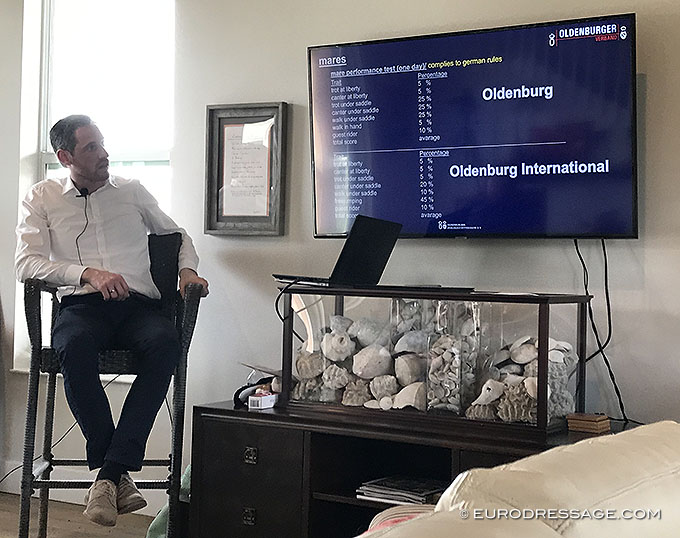
While Thoben gave a good explanation of what the studbook does, some of the breeders present still had questions. "How can I judge a good dam line," was one of the questions, as often a dam line gets valued purely based on the performance of the offspring in sport. "What if a foal gets sold to a bad rider?"
Thoben's advice to learn more about dam lines was to "educate yourself by watching and going to shows. Dr. Wolfgang Schleppinghoff is writing a book about dam lines. Go to the inspections, talk to the old breeders. You have to think in generations." For Americans this was not a satisfying answer as many of the "old German breeders" don't speak English and it's hard to access them in this digital world.
Breeders have an important role as they take the first step in making the match, but for riders pedigrees often don't count, but quality of gaits and rideability do.
ET and ICSI, the Holy Grail of Breeding?
During the lunch break, there was little rest. While the audience snacked on wonderful pasta and salad, Dr. Erin Newkirk gave a presentation on breeding the performance mare with a focus on ET and ICSI.

"With ET you track the cycle and it impacts the training schedule. You do the embryo flush under sedation after 7 - 8 days. Short cycle mares are brought back into heat to avoid an embryo was missed and it's also cleaner for her to cycle after a flush," Newkirk explained. Usually 1 or 2 eggs are picked up per flush. "On average it's 18 days from flush to flush." Newkirk said there is 70-80% pregnancy rate in the recipient mare. In the U.S.A, an ET procedure costs $5,000 - 8,000 USD, not counting the stud fee
Newkirk spoke about freezing embryos but called it "a logistical challenge" as "embryos need to be tiny to freeze well. It's not easy, you easily miss that window to flush them small." Oocytes are not frozen, but ICSI embryos are.
While most breeders think of ICSI as the method to use when a stallion has low-fertility, they seem to ignore that also the mare comes in play and has to undergo a very unpleasant procedure known as OPU (Ovum Pick-Up) or TVA (Transvaginal Aspiration). "You harvest the unfertilised egg. Lots of drugs go into your horse, sedation, NSAIDs, an epidural. It's a big procedure and very invasive as the ovary is manually retracted. Mares get uncomfortable," Erin said matter-of-factly. "ICSI is a very specialised technique which is often done for stallions who are dead or have poor sperm quality. It's micro-manipulation of the oocytes with the microscope."

8 months in foal to Painted Black
It was noted that in the U.S. it has become more difficult to find recipient mares. "Covid has caused a big rise in breeding and a backlog on frozen embryos," said Erin. "The market will settle out in the next few years."
Many American breeders complain about the poor quality of frozen semen, to which Erin replied, "as a whole the quality got better, but there are certain stallion stations who fail to improve their frozen, often because of the bacterial load."
"I Give a Mare Two to Three Chances"
A video connection was made with renowned hunter breeder Emil Spadone, who is based in Ocala, Florida, and he tuned in with the audience on his speciality.
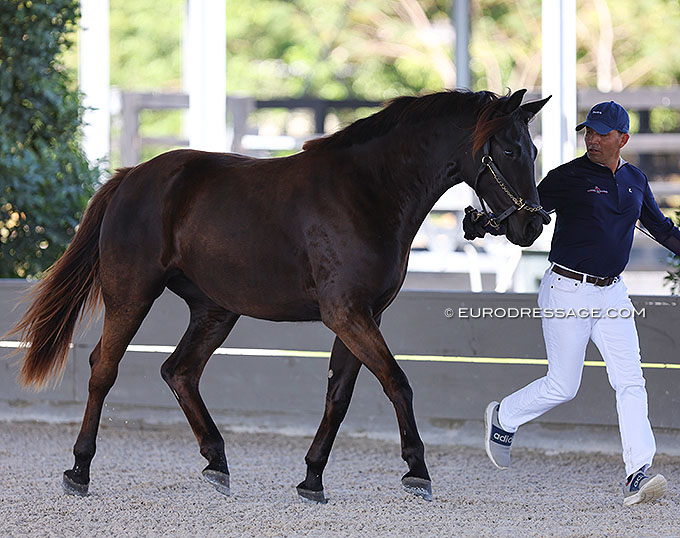
dressage or hunter future?
Spadone listed type and athleticism as the two key qualities he looks for in a hunter. "They need to have good conformation so they are healthy. A sturdy conformation and good balance."
When asked what the biggest mistake was he has made in breeding, he said in-breeding. "Don't breed too close. I got an unhealthy foal, it was unsound," he confessed.
Many owners have a very emotional connection with their mare and believe they are the star of the barn, unaware or ignoring the fact she is not producing the foal of coveted quality. They continue with her, nonetheless.
"I give a mare two to three chances," said Spadone. "If she was really good in sport, maybe four. If I don't get anything good I move on."
Marketing Foals in the U.S.A
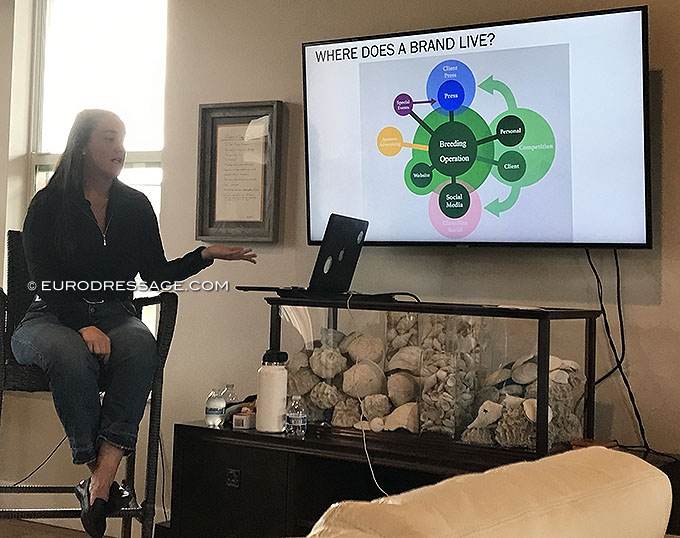
American breeders are particularly challenged in marketing their foals for a number of reasons: geographically as the country is so big and less easy to cross while inspecting foals; price-wise as the cost of breeding and keeping foals is almost double compared to Europe, automatically doubling the price of a foal. Furthermore Americans still deal with the stigma that "everything from Europe is better". A lot of buyers prefer to shop in Europe out of principle as it appears more fancy, exclusive, unique, prestigious, and better.
Hepner advocated that breeders need to create a "brand" out of their business. First of all they need to define their brand: what is the business goal, what are one's core values/expertise, what is the tone and manner when talking to clients. "Analyse your strengths and weaknesses. Prune and prioritise ideas, so that you will stand apart and become top of mind," she said.
She recommended breeders to elevate their online presence with a quality website, as well as on social media. Breeders need to plug into the current trends of "reels" which have a big reach for potential customers. They need to be "quick and attention grabbing" so they take action. "Tell a story, involve people in the journey of your horse. Post testimonials of riders who now have the offspring and build reputation trust," Hepner recommended.
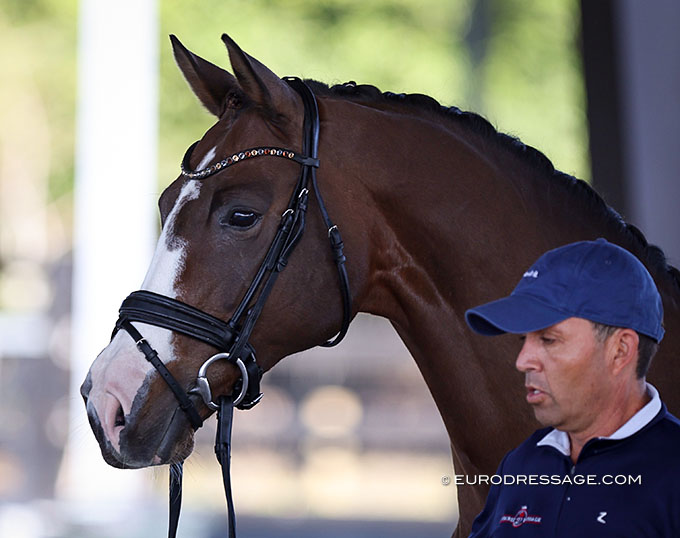
mock mare presentation and photoshoot
The question that was raised was if the Oldenburg verband could help American Oldenburg breeders sell their foals, either by offering a sales page on their website or by organizing an online auction. A long group discussion followed in which Thoben appeared positive and receptive to suggestions, while Richter was more skeptical as he did not see the possibility to have consistency in the videos with foals all over the country.
Pilgrims' Progress
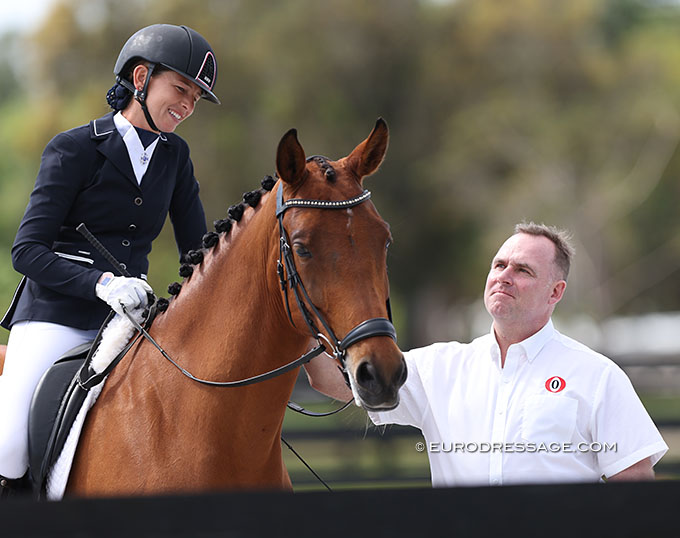
ridden by Rebecca Waite
The message to take away from this first annual GOV-NA meeting was that current and aspiring breeders can best start with a good mare and build a breeding programme on that foundation. Don't get blind-sided by fancy stallions who show five seconds of a spectacular trot or canter on a video or on photo. However, do make an effort to professionally showcase your foals online. The Oldenburg society vowed to look into the matter and support the breeders in marketing their foals.
Let's catch up in a year and see which progress has been made.
- Text and Photos © Astrid Appels
Rewatch the 2023 GOV-NA Breeders' Meeting on ClipMyHorse
Related Links
Februaries in Florida - Airplane Mode
Scott Hassler and Jessica Jo Tate Move High Performance Training Operations to Poinciana Farm
Poinciana Farm Making the Wellington Experience Carefree